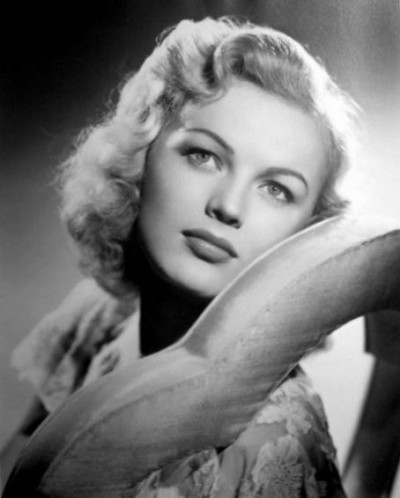June Haver (June Stovenour)

Born June Stovenour, June Haver was born in Rock Island, Illinois. She later took the last name of her stepfather Bert Haver. After the family moved to Ohio, seven-year-old Haver entered and won a contest of the Cincinnati Conservatory of Music. At age 10, she moved back to Rock Island, where she began performing for Rudy Vallee. Her mother being an actress and her father being a musician, Haver often doubted who she – careerwise – wanted to follow. At age eight, she won a film test by imitating famous actresses including Greta Garbo, Katharine Hepburn and Helen Hayes. Haver’s mother, however, prohibited her daughter from becoming a child actress in the film industry, feeling she was too young. Working regularly as a band singer by her teens, she performed with the Ted Fio Rito Orchestra for $75 a week. Other bandleaders she worked for were Dick Jurgens and Freddy Martin. Furthermore, she became a well-known child star on the radio. In the summer of 1942, June Haver moved to Hollywood, where she finished high school. She acted in plays in her spare time and during a performance as a southern belle, she was discovered by a scout from 20th Century Fox. In 1943, Haver signed a $3,500 a week contract with the studio and made her film debut playing an uncredited role as a hat-check girl in The Gang’s All Here. She was dropped shortly after, because the studio executives felt that she looked too young, but was later re-signed, after her costume and hairstyle were changed.
20th Century Fox had plans to mold June Haver as a glamour girl stand-in for the studio’s two biggest stars, Alice Faye and Betty Grable . She debuted on screen in a supporting role as Cri-Cri in Home in Indiana (1944). According to the actress, she had just turned seventeen years old when her scenes were filmed. Even before Home in Indiana was released, she was assigned to replace Alice Faye in the Technicolor-musical, Irish Eyes Are Smiling. Later that year she co-starred with future husband, Fred MacMurray, in Where Do We Go From Here?, which was the only time the pair appeared together in a film. During her career at Fox, Haver was originally groomed to be the next Betty Grable (standing a diminutive 5’2″, she was known as “Pocket Grable”). She even co-starred with Grable in the 1945 film, The Dolly Sisters, a film for which she had to put on weight. While filming, there were a lot of rumors about a possible clash between the two actresses, mostly because of their frequent comparison, but Haver refuted this with: “Betty is a big star and I’m just starting. I try to be nice to her, and she reciprocated by being just as nice to me. It’s silly to think two girls can’t work together without quarreling. You see, I’ve two sisters. I’m the ham between the bread and butter — the middle sister — and I understand girls pretty well. Betty likes to talk about her baby, so we talk about her baby.”
In 1946, she starred and received first-billing in Wake Up and Dream and Three Little Girls in Blue; both of which were well received and brought moderate success. The following year, the role of Katie was written into the film I Wonder Who’s Kissing Her Now just for Haver. Possibly best known for her roles in optimistic musicals, Haver’s comedy star-turn in 1948’s Scudda Hoo! Scudda Hay! was a major success. The same year, she starred as Marilyn Miller in the musical Look for the Silver Lining (1949). To resemble the actress as much as possible, Haver had to drive to the studio an hour earlier for make-up. The following year, she would star in The Daughter of Rosie O’Grady and I’ll Get By. In 1951, Haver was teamed with Fox’s newest asset, Marilyn Monroe, and previous co-star William Lundigan (her co-star from I’ll Get By), in the low-budget comedy, Love Nest. Even though Haver was the lead and received top-billing, most of the film’s publicity centered on Monroe, who had a minor role and garnered under-the-title billing. Love Nest was June Haver’s only full-length film in black and white. Her other 15 releases between 1943 and 1953 were shot in three-strip Technicolor, something of a record for a Hollywood Golden Age actress.
Following her marriage to Fred MacMurray, Haver remained largely retired from acting (her last appearances were as herself on The Lucy-Desi Comedy Hour in 1958 and Disneyland ’59). June Haver’s final film appearance would be in 1953’s The Girl Next Door. Haver and MacMurray would adopt two daughters and remained together until MacMurray’s death in 1991. At the urging of friends Ann Miller and Ann Rutherford, Haver finally joined the Academy of Motion Picture Arts and Sciences at the age of 75. For her contribution to the motion picture industry, June Haver has a star on the Hollywood Walk of Fame at 1777 Vine Street. June Haver died from respiratory failure on July 4, 2005, at her home in Brentwood, California at the age of 79 and was buried with her husband at Holy Cross Cemetery, in Culver City. She left two stepchildren (by MacMurray’s first marriage), her adopted twin daughters, and seven grandchildren.
Born
- June, 10, 1926
- USA
- Rock Island, Illinois
Died
- July, 04, 2005
- USA
- Brentwood, California
Cause of Death
- respiratory failure
Cemetery
- Holy Cross Cemetery
- Culver City, California
- USA



